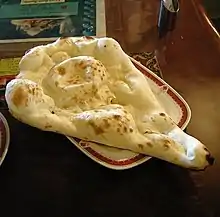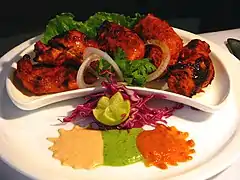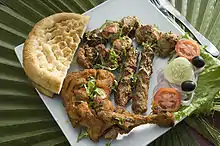Gulab jamun
Gulab jamun (also spelled gulaab jamun; lit. 'Rose water berry' or 'Rose berry') is a sweet confectionery or dessert, originating in Persia and then later introduced to the Indian subcontinent. It is popular in India, Pakistan as well as Myanmar. It is also common in nations with substantial populations of people with South Asian heritage, such as Mauritius, Fiji, Gulf states, the Malay Peninsula, Great Britain, South Africa, and the Caribbean countries of Trinidad and Tobago, Guyana, Suriname, and Jamaica.
.jpg.webp) Gulab jamun topped with almond slivers | |
| Alternative names | Gulab jaman, Lal mohan, Gulab jam, Gulap jam |
|---|---|
| Course | Dessert |
| Region or state | Indian subcontinent, Mauritius, Fiji, southern and eastern Africa, the Caribbean, the Malay Peninsula |
| Serving temperature | Hot, cold or at room temperature |
| Main ingredients | Khoa, saffron |
| Variations | Pantua, kalo jam |
It is made mainly from milk solids, traditionally from khoya, which is milk reduced to the consistency of a soft dough. Modern recipes call for dried or powdered milk instead of khoya. It is often garnished with dried nuts such as almonds and cashews to enhance flavour.
Preparation
In the Indian subcontinent, milk and cheese solids are prepared by heating milk over a low flame until the water content has evaporated and only the milk solids, known as khoya, remain. The solids are kneaded with flour (maida) and small balls of this dough are deep-fried in oil or ghee (clarified butter) at a low temperature,[1] then soaked in a light sugar syrup flavored with green cardamom and rose water, kewra or saffron.[2] Hot gulab jamun is often served with vanilla ice cream or kulfi.
Origins
Gulab jamun was first prepared in Persia and then brought to medieval India. It was derived from a fritter that the Central Asian Turkic People brought to India.[3]
The word "gulab" is derived from the Persian words gol (flower) and āb (water), referring to the rose water-scented syrup. "Jamun" or "jaman" is the Hindi/Urdu word for Syzygium jambolanum, an Indian fruit with a similar size and shape, commonly known as black plum.[4] Jamun is also defined as a fried delicacy in sugar syrup.[5] The Arab dessert luqmat al-qadi is similar to gulab jamun, although it uses a different batter. According to the culinary historian Michael Krondl, both luqmat al-qadi and gulab jamun may have derived from a Persian dish, with rose water syrup being a common connection between the two.[6]
Special occasions
Gulab jamun is often eaten at festivals, birthdays or major celebrations such as marriages, the Muslim celebrations of Eid ul-Fitr and Eid al-Adha, and the Hindu festivals of Diwali and Ganesh Chaturthi. There are various types of gulab jamun.
 Gulab jamun in a glass
Gulab jamun in a glass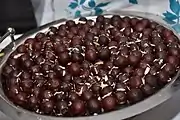 Gulab jamun with almond pieces
Gulab jamun with almond pieces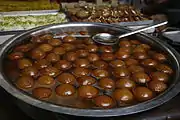 Gulab jamun often comes with chashni syrup
Gulab jamun often comes with chashni syrup Served with saffron
Served with saffron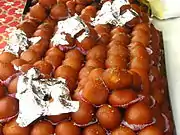 With vark
With vark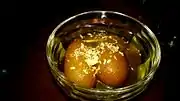 Two pieces of Gulab jamun
Two pieces of Gulab jamun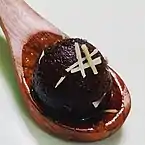 Mini Gulab Jamun
Mini Gulab Jamun
Variants


India
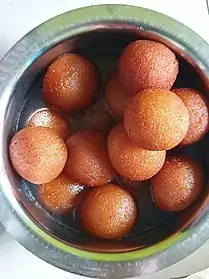
Gulab jamun gets its brownish red colour because of the sugar content in the milk powder (khoya). In other types of gulab jamun, sugar is added in the batter, and after frying, the sugar caramelization gives it its dark, almost black colour, which is then called kala jamun or "black jamun". The sugar syrup may be replaced with (slightly) diluted maple syrup for a gulab jamun.
Homemade gulab jamun is usually made up of khoya, a pinch of all-purpose flour/refined wheat flour/ wheat flour (optional), baking powder and clarified butter (ghee); milk kneaded to form a dough, moulded into balls, deep fried and dropped into simmering sugar syrup.
In Bengali, Gulab Jamun is known as Kalo Jam or Pantua, which is similar to gulab jamun, and could be called a Bengali variant of that dish.[7] Ledikeni, a variation of Pantua, is another variant of gulab jamun.[8] It is said to have been invented by Bhim Chandra Nag on the occasion of a visit by Lady Canning, the wife of Charles Canning, the Governor-General of India during 1856–62.
Katangi, a town near Jabalpur is famous for "Jhurre Ka Rasgulla", which has been made there for the past 100 years.[9][10] It is several times the size of normal gulab jamuns and is prepared in local desi ghee.[11]
In Rajasthan, instead of soaking gulab jamun balls in sugar syrup, they are cooked in gravy made from spices, nuts and tomato to make popular Gulab Jamun ki Sabzi.
Bangladesh
In Bangladesh, Pantua is available almost everywhere throughout the country, which can be referred to a Bengali variation of Gulab jamun. Also there are two kinds of jamuns that are famous. They are Golap Jam (গোলাপ জাম) and Kalo Jam (কালো জাম).
See also
References
- Marty Snortum, Lachu Moorjani (2005). Ajanta: regional feasts of India. Gibbs Smith. p. 17. ISBN 1-58685-777-0.
- shraddha.bht. "Gulab Jamoon". Konkani Recipes. Retrieved 25 May 2010.
- Michael Krondl (1 June 2014). The Donut: History, Recipes, and Lore from Boston to Berlin. Chicago Review Press. p. 7. ISBN 978-1-61374-673-8.
- [Banerjee, A; Dasgupta, N; De, B (2005). "In vitro study of antioxidant activity of Syzygium cumini fruit". Food Chemistry. 90 (4): 727. doi:10.1016/j.foodchem.2004.04.033]
- Achaya K. T. (1994). Indian Food Tradition A Historical Companion. ISBN 9780195628456. Retrieved 29 January 2019.
- Michael Krondl (2011). Sweet Invention: A History of Dessert. Chicago Review Press. p. 38. ISBN 978-1-55652-954-2.
- Charmaine O'Brien (2003). Flavours of Delhi: A Food Lover's Guide. Penguin Books Limited. p. 145. ISBN 978-93-5118-237-5.
- Richardson, Tim H. (2002). Sweets: A History of Candy. Bloomsbury USA. p. 334. ISBN 1-58234-229-6.
- "यहां के रसगुल्लों के लिए थम जाते हैं वाहनों के पहिए". www.patrika.com. Retrieved 24 September 2019.
- उसमें प्राण जगाओ साथी- 3, मायाराम सुरजन, Deshbandhu, 2009-11-12, जबलपुर-दमोह के बीच कटंगी के रसगुल्ले, 1959
- "Folk music. Katangi ke rasgulla. AKASH sahu". Retrieved 24 September 2019 – via www.youtube.com.
- sampurna. "सबैको प्यारो लालमोहन". Sampurna Weekly. Retrieved 5 December 2022.

